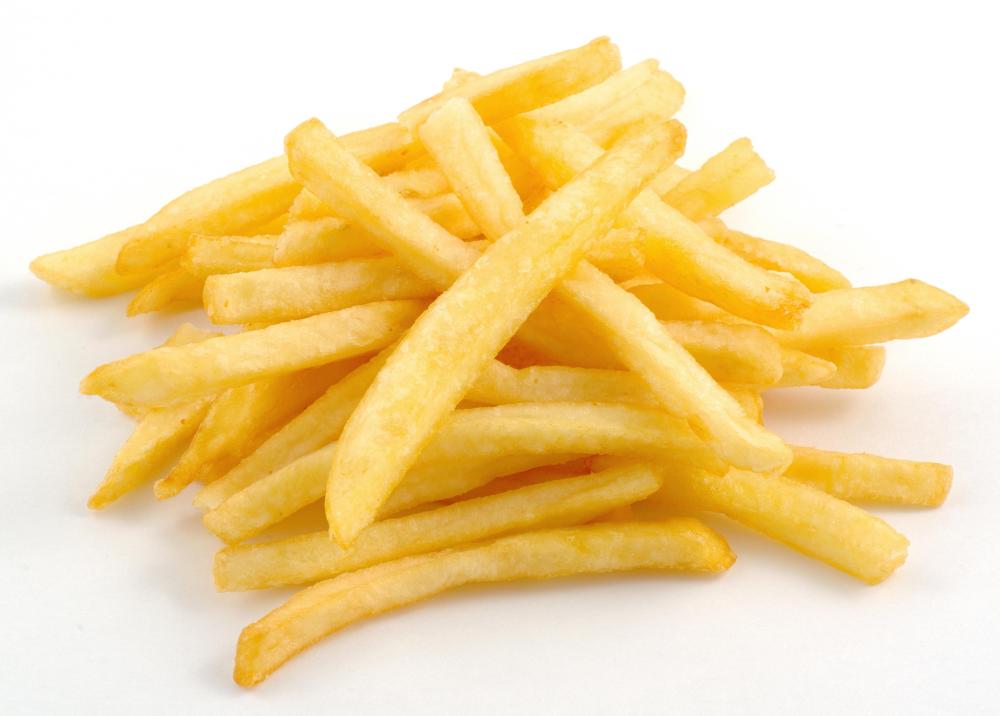At DelightedCooking, we're committed to delivering accurate, trustworthy information. Our expert-authored content is rigorously fact-checked and sourced from credible authorities. Discover how we uphold the highest standards in providing you with reliable knowledge.
What is Deep Frying?
Deep frying is a cooking technique in which food is totally immersed in extremely hot oil or fat. Because oil conducts heat very well, deep frying is a very rapid cooking technique, and it produces foods which are ideally crispy on the outside, and soft on the inside. Many cultures have a long tradition of deep frying, especially for the purpose of creating snack foods, and deep fried foods are commonly on offer at restaurants and street stands around the world. Cooks can also deep fry at home.
Although this cooking process sounds simple, it is actually a bit tricky. The goal is to get the oil hot enough to sear the outside of the food without penetrating into the inner layers, so that the food actually steams from inside out as the water in the food is heated by the surrounding oil. If the temperature is too high, the outside of the food will be burned, and the inside will be raw, but if it is too low, the oil will penetrate the food, making it greasy and heavy.

The most ideal temperature for deep frying is around 350 degrees Fahrenheit (177 degrees Celsius). This means that the oil must have a very high smoking point, to ensure that it does not burn or catch fire during the deep frying process. Safflower and peanut oil are both great choices for deep frying, as is lard. Butter and olive oil are poor choices, as they have very low smoking points, although gee, also known as clarified butter, can make a great deep frying medium.

Deep frying can also be dangerous, because of the hot oil. The oil can cause severe burns if people are splashed, and it is easy for a fire to start during a deep frying session. Safety can be increased by using long slotted spoons to manipulate food in the deep fryer, monitoring the temperature with a good thermometer, and putting up screens to limit splashback. If a fire does start while deep frying, a fire extinguisher specifically designed for grease fires should be used, or baking soda can stand in at a pinch: water should never be thrown on a grease fire.

After food has been deep fried, it is typically allowed to drain on towels or in a slotted container. Draining allows excess oil to flow off, reducing the potential greasiness of the food. It is generally best to eat deep fried foods hot, while they are still crispy and fresh, as cold deep fried foods can be soggy, greasy, and quite unpleasant. Excess oil can be saved for re-use if it has not burned, or it may be packaged for disposal. In some communities, facilities for recycling cooking oil are available, but otherwise the oil should be thrown away, as pouring it down the sink can lead to clogs in the future.
AS FEATURED ON:
AS FEATURED ON:















Discussion Comments
My mom just gave me her old deep fryer and I'm very excited to start using it. She's decided that she needs to eat healthier, but I don't think there is anything wrong with deep frying if you do it the right way, and if you make sure you're not eating deep fried foods every night of the week.
I've never used one before though, and I really want to get creative with what I make in it. Where can I find different deep frying recipes?
I never really thought of deep frying in oil as being a fire hazard. I didn't realize a fire could start so easily when deep frying foods. I also didn't know that baking soda could put out a grease fire. I have a small fire extinguisher in the kitchen, but it seems like it would be easier to keep baking soda within reach, should a small fire occur.
This is all very helpful information. Thank you for sharing!
Post your comments